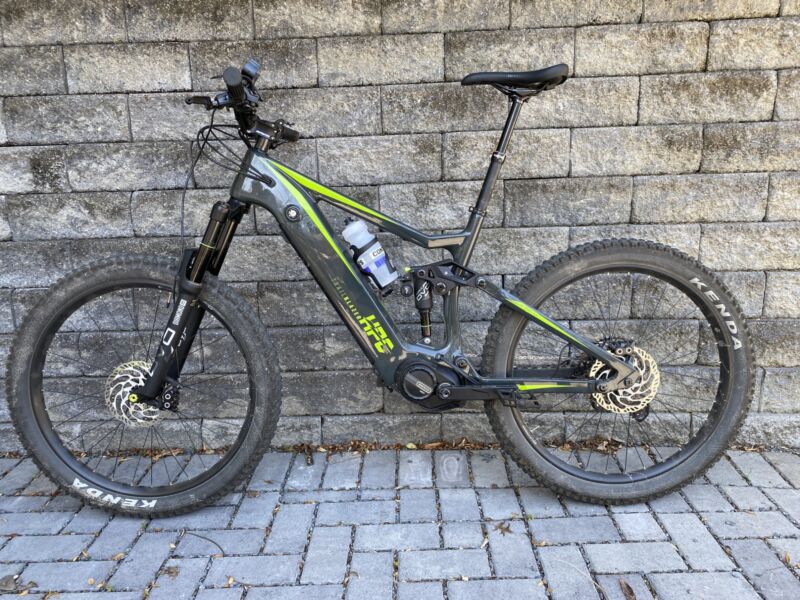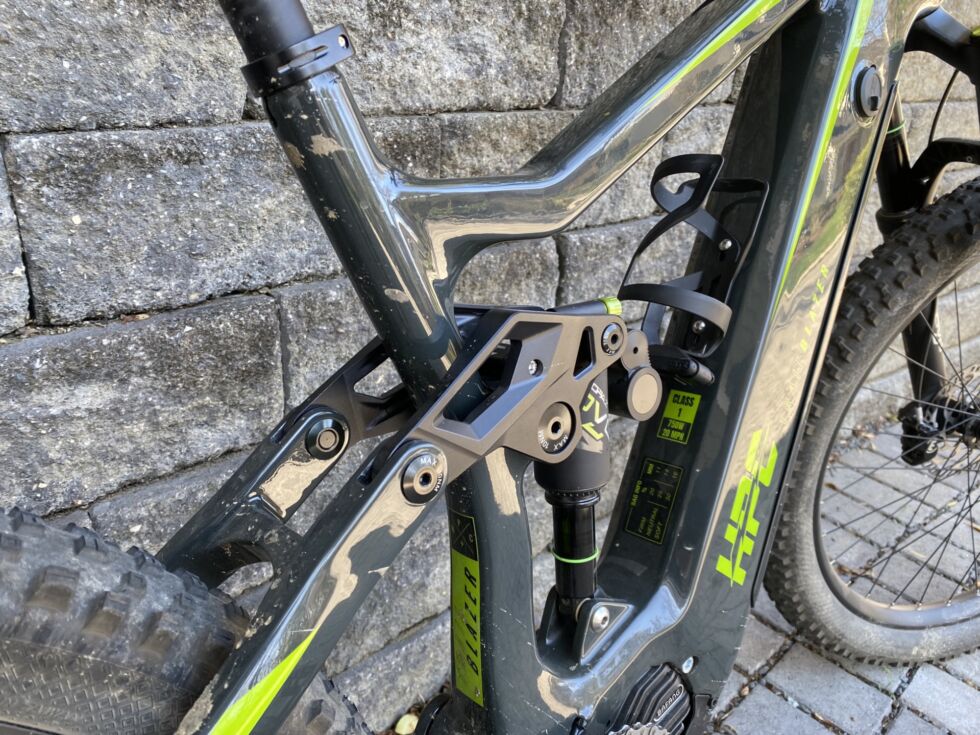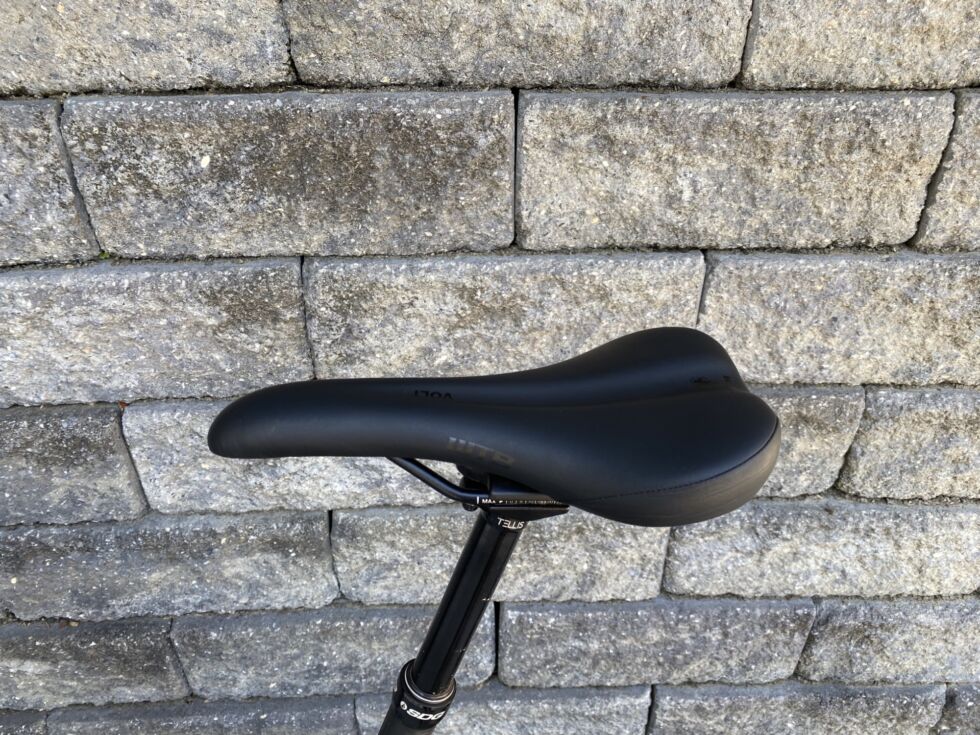
I found myself in the air long enough to give some thought to how I could land while remaining atop the bicycle I had been riding the instant before I hit the jump. Based on similar experiences while skiing, I immediately recognized that this invariably meant very bad things. A few seconds later, as I was brushing dirt out of the abrasions I had just picked up, I contemplated where I had gone wrong.
Once again, I had misunderstood HPC's Trailblazer e-mountain bike. Doing so had become a feature of the time I spent using the bike.
The Trailblazer looks like a solid, hefty beast of a bike (that's not an insult—I got compliments on its looks while taking a train to some trails). It's covered with components that are likely to be unfamiliar to people who know the default sets that come with bikes from large manufacturers. But if you do some research on the components, you realize that the Trailblazer was specced by someone with deep knowledge and fairly particular tastes. And the ride the bike provided has some surprisingly subtle qualities that took me a while to adjust to.
Spare parts
High Performance Cycles offers two models of Trailblazer, the base and the Pro, and both have the same carbon fiber frame. They differ almost entirely based on their components, with the Pro having mostly top-of-the-line material befitting its $9,000 price tag and the base model costing $6,400 for very-good-but-still-a-step-down level components. You can increase the price of either by purchasing more capacious batteries, faster chargers, lights, or even an internal geared hub. (Note that the company has just updated the specs for 2024.)
You can also pay to boost the motor to one capable of speeds that will make you a danger to yourself and others, which will also make the bike illegal to use on anything but private property. Let's get one thing out of the way here: Making an e-bike that can reach 65 km/hr (40 mph), as some Trailblazer configurations can, is a mistake. But HPC sent me the low-end model that behaved as a standard Class 1 e-bike, with a maximum speed of 32 km/hr (20 mph), so that's what this review is about.
Advertisement
Most of the components you'll find on mountain bike frames come from just a handful of manufacturers. And HPC relies on some of them (notably SRAM drivetrains). But smaller design companies stay afloat through a combination of replacements for broken parts, tempting people with upgrades, or offering some specific features that aren't well-served by the more generic designs of major manufacturers. The Trailblazer leans heavily into those.
For example, the tires come from Kenda and have a reputation for great grip at the expense of high rolling resistance—a drawback that matters less when you have an electric assist. The forks and shocks come from a company called DVO and have an adjustment that, based on what I've read, should help compensate for the added weight of the hardware. Bafang, which provides the motor, isn't a household name, but it's a major player in electrified cycling. I'd already identified the WTB Volt as a highly rated saddle and was pleased to find one on the bike to try out. I could go through the rest of the bike's specs and say similar things about the other components.

Overall, the parts list felt quirky, and it might give someone who's expecting big names some pause. But every component I looked into had some features that made it a good (or at least interesting) choice for an e-mountain bike.
The electronics
As mentioned above, the Trailblazer comes with a motor from Bafang, which integrates into the cranks. As with the Specialized mid-motor e-bike I reviewed last year, this has the odd feature of eliminating the direct connection between the cranks and the chain ring; if you turn the cranks backward, the chain does't move. When in use, the motor produced a slightly audible whistle/whine. Riding over crunchy gravel was enough to drown it out entirely, and the noise of the knobby tires on paved surfaces largely canceled it as well, so this is not one of those bikes that lets everyone within a quarter mile know something electric is coming.
The motor is controlled by a set of buttons next to the left grip. These include the power button and up/down buttons that let you cycle through five levels of assist, plus a "don't bother" setting that leaves the motor off. One very nice touch: button presses have audible and haptic feedback, so you know without looking that you've successfully performed an action.
There's a small screen that displays speed, assist level, and remaining battery capacity, which is all you really need. Unfortunately the contrast and brightness of the screen can make it extremely difficult to read with sunglasses on. Not only is this unfortunate for a product intended for an outdoor activity, it was especially bad for me because my sunglasses incorporate a reading lens for my ever-aging eyes.
- The Trailblazer's screen has all the right information but is often hard to read.JOHN TIMMER
- The controls look routine but offer welcome haptic feedback.JOHN TIMMER
HPC also included a throttle that can be plugged in and clamped on to the handlebars next to the control buttons, something I didn't bother with. I have, however, gotten used to the throttle's location on the handlebars being where the lever that controls the dropper seat lives. Keeping it empty for the throttle necessitated moving the seat control to just above the triggers that control the rear derailleur, something I never got comfortable with. If I owned the bike, I'd cut some zip ties and move it back to where it belongs.
HPC rates the smallest capacity battery as good for about 25 miles, which seemed about right in my experience. If you're planning on using the Trailblazer to get you to and from some trails and power you through the trail-riding experience, it's probably worth investing in one of the battery upgrades.
Beast mode
The Trailblazer's beast-like appearance is more than skin-deep—at over 23 kg (50 lbs), looks are not entirely deceiving. Plus it's specced out as an enduro bike, which is sort of the middle-of-the-road option: it will hold up to rugged downhills better than a trail bike but not as well as a dedicated downhill machine. (Typically, as it does here, this means a firmer shock and fork that both have a larger range of travel.) But that ruggedness can mean some sacrifices in pedaling and responsiveness.
My impressions of the Trailblazer have been shaped by owning a non-electric, full-suspension trail bike, which I purchased after reviewing my first e-mountain bike. During my first review, I was struck by how much the added weight of a motor and batteries limited an e-mountain bike's responsiveness. But owning a far lighter mountain bike helped me recognize that this is a bit of a double-edged sword. While the light weight of a non-electrified bike may make it easier to force it into doing what you want, it also makes it easier for the ground to force it to do things you don't want.
Put simply, the added weight adds a greater sense of control at the cost of making you a bit less in touch with what's going on under your wheels.

How did this play out on the Trailblazer? It's heavy, so it definitely offered the control you'd expect. But despite its heavy weight, it was remarkably maneuverable; there was no terrain that caused me problems that wouldn't have also caused me problems on my far lighter trail bike. While the suspension might have smoothed over the terrain a bit more than I'd have liked, it also limited the sag I experienced when standing in the pedals.
I probably could have taken a little air out of the suspension to get something a bit closer to my tastes if I really wanted—HPC sent along a pump for those adjustments. And its DVO suspension deserves credit for providing a very large difference between its firm and relaxed settings, which made it easy to adjust to things on the fly.
Surprisingly, despite the bulk, it was also perfectly fine to pedal the bike with the assist shut off entirely. I wouldn't want to spend all day doing that, nor would I want to tackle any significant hills, but handling the flats without an assist is a perfectly viable way to extend the bike's battery life.
The electric assist took some work to really figure out. On most bikes I've tested, the settings influence both the torque (how quickly you can accelerate) and the maximum speed. So while an e-bike might be capable of hitting 30 km/hr, it will often max out at 20 on its lowest assist setting. That was not the case with the Trailblazer. While higher settings upped the torque, even the lowest setting would easily get you nearly to the bike's maximum speed—and do so fairly quickly. This is what got me in trouble on the jump I mentioned up top—I underestimated how quickly the Trailblazer would get me up to a speed that would send me airborne.
Advertisement
Over time, I developed a feel for how to work with the assist more effectively, learning how to cruise at slower speeds on flat ground and how far to upshift on hills. But instead of the assist feeling like a natural extension of my efforts, it definitely required adjustments on my part.
Hard to sum up
So what to make of the Trailblazer? The base model offers a pretty competitive price for a carbon fiber electric mountain bike, although you'll probably want to spend a bit extra to get a more capacious battery. That will get you some pretty tough equipment ready to handle terrain that might brutalize lesser bikes, but with a relatively tame experience on less challenging terrain. To get the most out of it, you'll probably want to tweak some of the hardware and spend some time learning how to work with the assist. And there are competitors who offer bikes that don't require that effort to give you a good riding experience.
Still, if you're willing to make the effort, the Trailblazer offers a pretty distinctive ride, one that handles rough terrain well without sacrificing much in the way of maneuverability. If that experience is what you're looking for, it's definitely worth considering.



















